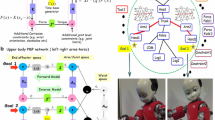Abstract
We present a method for autonomous learning of dextrous manipulation skills with multifingered robot hands. We use heuristics derived from observations made on human hands to reduce the degrees of freedom of the task and make learning tractable. Our approach consists of learning and storing a few basic manipulation primitives for a few prototypical objects and then using an associative memory to obtain the required parameters for new objects and/or manipulations. The parameter space of the robot is searched using a modified version of the evolution strategy, which is robust to the noise normally present in real-world complex robotic tasks. Given the difficulty of modeling and simulating accurately the interactions of multiple fingers and an object, and to ensure that the learned skills are applicable in the real world, our system does not rely on simulation; all the experimentation is performed by a physical robot, in this case the 16-degree-of-freedom Utah/MIT hand. Experimental results show that accurate dextrous manipulation skills can be learned by the robot in a short period of time. We also show the application of the learned primitives to perform an assembly task and how the primitives generalize to objects that are different from those used during the learning phase.
Similar content being viewed by others
Explore related subjects
Discover the latest articles, news and stories from top researchers in related subjects.References
Arbib, M., Iberall, T., and Lyons, D. 1983. Coordinated control programs for movements of the hand. Technical Report 83-25, Department of Computer and Information Science, University of Massachusetts at Amherst, Amherst, MA.
Arts, E.H.L. and Korst, J. 1989. Simulated Annealing and Bolzmann Machines, Wiley: Chichester.
Bellman, R.E. 1957, Dynamic Programming, Princeton University Press: Princeton, NJ.
Born, J. 1978. Evolutionsstrategien zur numerischen Lösung von adaptationsaufgaben. Ph.D. thesis, Humboldt Universität, Berlin, Germany.
Christiansen, A.D., Mason, M.T., and Mitchell, T.M. 1990. Learning reliable manipulation strategies without initial physical models. In Proceedings of the IEEE International Conference on Robotics and Automation, Cincinnati, OH., pp. 1224-1230.
Dunn, G.B. and Segen, J. 1988. Automatic discovery of robotic grasping configurations. In Proceedings of the IEEE International Conference on Robotics and Automation, pp. 396-401.
Eiben, A.E., Aarts, E.H.L., and Van Hee, K.M. 1991. Global convergence of genetic algorithms: An infinite Markov chain analysis. In Proceedings of the First International Conference on Parallel Problem Solving from Nature, Berlin, Germany, Springer, pp. 4-12.
Fuentes, O. and Nelson, R.C. 1996a. Experiments on dextrous manipulation without prior object models. In Proceedings of the IEEE International Symposium on Intelligent Control, Dearborn, MI.
Fuentes, O. and Nelson, R.C. 1996b. The virtual tool approach to dextrous telemanipulation. In Proceedings of the IEEE International Conference on Robotics andAutomation, Minneapolis, MN, pp. 1700-1705.
Grossman, T. and Davidor, Y. 1992. An investigation of a genetic algorithm in continuous parameter space. Technical Report CS92-20, The Weizmann Institute of Science, Department of Applied Mathematics and Computer Science, Revhovot, Israel.
Iberall, T. 1987. The nature of human prehension: Three dextrous hands in one. In Proceedings of the 1987 IEEE International Conference on Robotics and Automation, Raleigh, NC, pp. 396-401.
Jacobsen, S., Iversen, E., Knutti, D., Johnson, R., and Bigger, K. 1986. Design of the Utah/MIT Dextrous Hand. In Proceedings of the IEEE International Conference on Robotics and Automation, pp. 96-102.
Jägersand, M., Fuentes, O., and Nelson, R.C. 1996. Acquiring visual-motor models for precision manipulation with robot hands. In Proceedings of the Fourth European Conference on Computer Vision, Cambridge, U.K.
Kamon, I., Flash, T., and Edelman, S. 1996. Learning to grasp using visual information. In Proceedings of the IEEE International Conference on Robotics and Automation, Minneapolis, MN, pp. 2470-2476.
Maes, P. and Brooks, R.A. 1990. Learning to coordinate behaviors. In Proceedings of AAAI-90, pp. 796-802.
Matarić, M. 1994. Reward functions for accelerated learning. In Proceedings of the Eleventh International Conference on Machine Learning, pp. 181-189.
Matarić, M. 1997. Learning social behavior. Robotics and Autonomous Systems, 20:191-204.
Michelman, P. and Allen, P. 1993. Compliant manipulation with a dexterous robot hand. In Proceedings of the IEEE International Conference on Robotics and Automation, Atlanta, GA, pp. 711-716.
Narasimhan, S. 1988. Dexterous robot hands: Kinematics and control. Master's thesis, MIT Artificial Intelligence Laboratory, Cambridge, MA.
Nelson, R.C., Jägersand, M., and Fuentes, O. 1995. Virtual tools: A framework for simplifying sensory-motor control in complex robotic systems. In Proceedings of the Workshop on Vision for Robots, Pittsburgh, PA.
Quinlan, J.R. 1986. Induction of decision trees. Machine Learning, 1:81-106.
Rechenberg, I. 1973. Evolutionsstrategie: Optimierung Technischer Systeme nach Prinzipien der Biologischen Evolution, Frommann-Holzboog Verlag: Stuttgart.
Salganicoff, M., Kunin, L.G., and Ungar, L.H. 1994. Active exploration based ID-3 learning for robot grasping. In Workshop on Robot Learning, New Brunswick, NJ.
Schwefel, H.-P. 1981. Numerical Optimization of Computer Models, John Wiley & Sons.
Speeter, T.H. 1991. Primitive based control of the Utah/MIT dextrous hand. In Proceedings of the IEEE International Conference on Robotics and Automation, Sacramento, CA, pp. 866-877.
Author information
Authors and Affiliations
Rights and permissions
About this article
Cite this article
Fuentes, O., Nelson, R.C. Learning Dextrous Manipulation Skills for Multifingered Robot Hands Using the Evolution Strategy. Autonomous Robots 5, 395–405 (1998). https://doi.org/10.1023/A:1008822709073
Issue Date:
DOI: https://doi.org/10.1023/A:1008822709073




